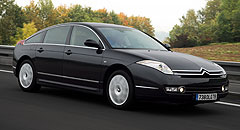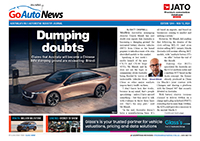Make / Model Search
Future models - Citroen - C5Citroen upsizes V6 dieselBigger is better: The Citroen C5 will get a bigger, 3.0-litre diesel next year in Australia, with more power and improved fuel economy. Ford-made 3.0-litre twin-turbo diesel to be dropped into next year’s Citroen C5, C615 Jun 2009 CITROEN will launch an upgraded V6 HDi diesel powerplant in Australian-bound C5 and C6 luxury car models sometime in the middle of next year. The French company also has taken the opportunity to fit larger front disc brakes to help cope with the performance increase, as well as variable-capacity steering to maximise efficiency and reduce consumption, plus an improved alternator that charges only when necessary. Based on the 3.0-litre V6 twin turbo-diesel that has just been released in the Jaguar XF and is heading for the Land Rover Discovery before the end of 2009, the new engine lifts power and torque but slashes fuel consumption and emissions compared to its 150kW/440Nm 2.7-litre V6 HDi twin-turbo predecessor. Dubbed the 3.0 V6 HDi 240 FAP to reflect its European horsepower rating, the 2993cc engine delivers 18 per cent more power (177kW at 3800rpm) and about 12 per cent more torque (450Nm from 1600 to 3600rpm). This translates into a 0-100km/h sprint-time of 7.9 seconds in the C5 (formerly 9.6s) and 8.5 seconds in the C6 (previously rated at 8.9 seconds).  Left: Citroen C6. Left: Citroen C6.Nevertheless, there are significant gains in fuel consumption, with the 7.4 litres per 100km average representing a cut of 1.0L/100km and 1.5L/100km in the C5 and C6 respectively, while the 195 grams per kilometre of carbon dioxide emissions is 12 to 15 per cent better than before. As a result, the 3.0 V6 HDi meets Euro V emissions standards that become mandatory from January 2011. The standard gearbox is a six-speed automatic transmission, directing drive to the front wheels on both Citroen models. Spurring on the changes are a 272cc capacity increase, third-generation direct common-rail injection system using injection pressures of up to 2000 bars, compared with 1650, revised combustion chambers, twin variable displacement turbochargers, a revamped exhaust gas recirculation set-up that improves the thermal capability of the fuel/water exchange by 40 per cent, and an energy recovery system during deceleration and braking via a special new alternator. The 3.0 HDi, as well as its 2.7-litre diesel predecessor, is the result of a PSA Peugeot Citroen/Ford collaboration, and is the only non-PSA designed diesel engine used in the French marques’ passenger car line-up. Ironically, with the 2008 sale of Jaguar and Land Rover to India’s Tata Corporation, no Ford-owned or branded vehicle currently uses this engine, which is built by Ford at its Dagenham, London plant in the UK. Other vehicles to use it in 2.7-litre guise include the Peugeot 407, 407 Coupe and 607, Jaguar XJ and Land Rover Range Rover Sport. This is also the powerplant that has been most often linked to any future diesel Ford Falcon and Territory models built in Australia. All future models Alfa Romeo Alfa Romeo Abarth Abarth Alpine Alpine Alpina Alpina Audi Audi Aston Martin Aston Martin BMW BMW Bentley Bentley Chery Chery Brabham Brabham Chrysler Chrysler Chevrolet Chevrolet Cupra Cupra Citroen Citroen DS DS Dodge Dodge Fiat Fiat Ferrari Ferrari Foton Foton Ford Ford Great Wall Great Wall FPV FPV Haval Haval GWM GWM Honda Honda Holden Holden Hummer Hummer HSV HSV Infiniti Infiniti Hyundai Hyundai Jaguar Jaguar Isuzu Isuzu Kia Kia Jeep Jeep Land Rover Land Rover Lamborghini Lamborghini Lexus Lexus LDV LDV Mahindra Mahindra Lotus Lotus Mazda Mazda Maserati Maserati Mercedes-AMG Mercedes-AMG McLaren McLaren MG MG Mercedes-Benz Mercedes-Benz Mitsubishi Mitsubishi Mini Mini Opel Opel Nissan Nissan Peugeot Peugeot Pagani Pagani Proton Proton Porsche Porsche Renault Renault Ram Ram Rover Rover Rolls-Royce Rolls-Royce Skoda Skoda Saab Saab SsangYong SsangYong Smart Smart Suzuki Suzuki Subaru Subaru Toyota Toyota Tesla Tesla Volvo VolvoMotor industry news |
Click to shareCitroen modelsResearch Citroen All future models Alfa Romeo Alfa Romeo Abarth Abarth Alpine Alpine Alpina Alpina Audi Audi Aston Martin Aston Martin BMW BMW Bentley Bentley Chery Chery Brabham Brabham Chrysler Chrysler Chevrolet Chevrolet Cupra Cupra Citroen Citroen DS DS Dodge Dodge Fiat Fiat Ferrari Ferrari Foton Foton Ford Ford Great Wall Great Wall FPV FPV Haval Haval GWM GWM Honda Honda Holden Holden Hummer Hummer HSV HSV Infiniti Infiniti Hyundai Hyundai Jaguar Jaguar Isuzu Isuzu Kia Kia Jeep Jeep Land Rover Land Rover Lamborghini Lamborghini Lexus Lexus LDV LDV Mahindra Mahindra Lotus Lotus Mazda Mazda Maserati Maserati Mercedes-AMG Mercedes-AMG McLaren McLaren MG MG Mercedes-Benz Mercedes-Benz Mitsubishi Mitsubishi Mini Mini Opel Opel Nissan Nissan Peugeot Peugeot Pagani Pagani Proton Proton Porsche Porsche Renault Renault Ram Ram Rover Rover Rolls-Royce Rolls-Royce Skoda Skoda Saab Saab SsangYong SsangYong Smart Smart Suzuki Suzuki Subaru Subaru Toyota Toyota Tesla Tesla Volvo VolvoMotor industry news |









Facebook Twitter Instagram